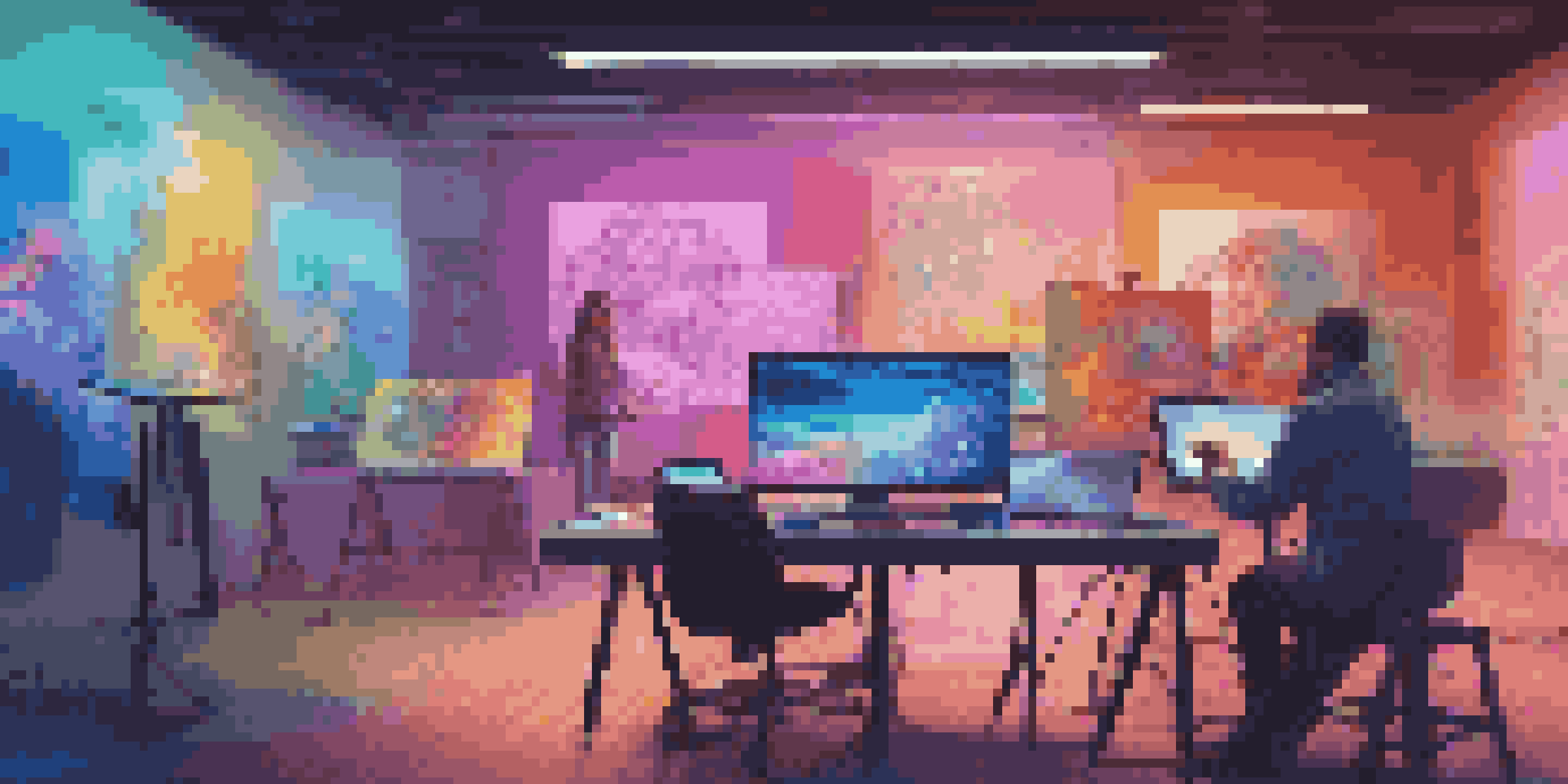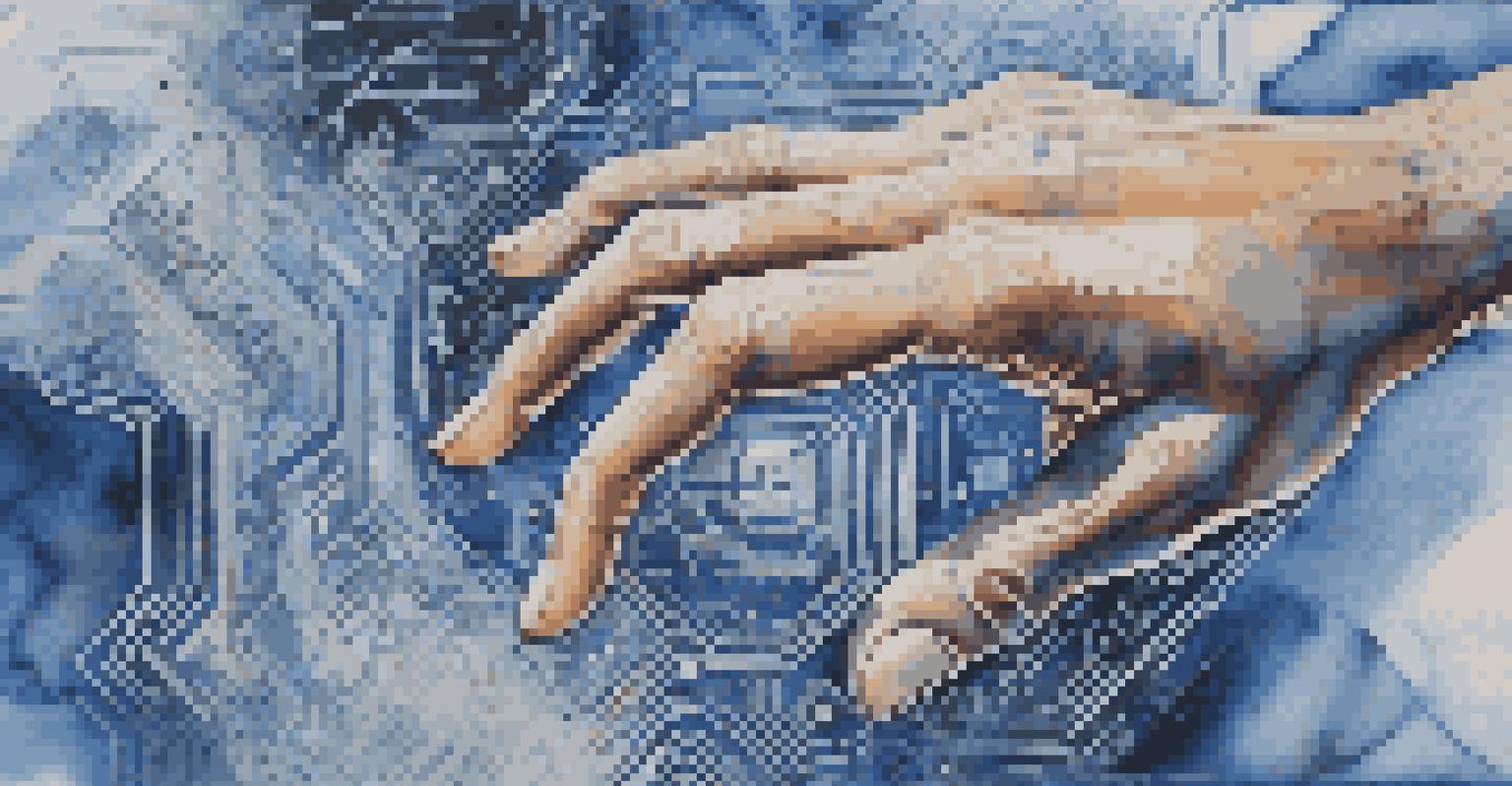The Influence of Technology on Contemporary Art Practices

The Evolution of Art Through Technology
Art has always evolved with technology, from cave paintings to digital art. Each technological advancement has opened new avenues for creativity and expression. For instance, the invention of the camera in the 19th century changed how artists approached realism and narrative. Today, we see artists using software and hardware to create immersive experiences, blending visual art with interactivity.
Every artist dips his brush in his own soul, and paints his own nature into his pictures.
As artists embrace new tools, traditional art forms are also being redefined. Techniques like 3D printing allow for sculptures that were once impossible to create by hand. This blending of old and new not only expands the definition of art but also challenges our understanding of artistic skill and craftsmanship.
Moreover, technology in art invites audiences to engage differently. Interactive installations can invite viewers to become part of the artwork, transforming passive observation into active participation. This shift is crucial in a world where audience engagement is more important than ever.
Digital Art: A New Frontier
Digital art has surged in popularity, offering artists a limitless canvas for their creativity. From digital painting to generative art, the possibilities are virtually endless. Artists can experiment with colors, shapes, and forms in ways that traditional mediums cannot match, making digital art a playground for innovation.

The rise of platforms like Instagram and TikTok has also changed how digital artists share their work. Social media enables instantaneous feedback and connection with a global audience, allowing artists to build their brands and communities in real time. This democratization of art distribution empowers emerging artists to gain visibility without relying solely on galleries or traditional institutions.
Technology Transforms Artistic Expression
Advancements like digital art, VR, and AI are reshaping how artists create and engage with audiences.
However, the digital landscape is not without its challenges. Issues such as copyright and ownership can become murky in the online space. As artists navigate this new frontier, they must also advocate for their rights and the value of their digital creations.
The Role of Social Media in Art Promotion
Social media has fundamentally changed how artists promote their work and connect with audiences. Platforms like Instagram and Pinterest serve not just as galleries, but as networking tools for artists. They can showcase their portfolios, share behind-the-scenes processes, and even sell artwork directly to consumers.
Art is not freedom from discipline, but disciplined freedom.
This shift has led to a more personal relationship between artists and their audience. Fans can engage directly with creators, fostering a sense of community and loyalty. Artists often share their stories, inspirations, and struggles, making their work more relatable and grounded in real-life experiences.
Nonetheless, the pressure to maintain an online presence can be overwhelming for some artists. Balancing the act of creating with constant self-promotion can lead to burnout. Finding the right balance is crucial for sustaining both creativity and a healthy online persona.
Virtual Reality and Immersive Experiences
Virtual reality (VR) is transforming how we experience art. Artists are now creating fully immersive environments that transport viewers to different worlds. These experiences challenge traditional notions of space and perspective, encouraging audiences to engage with art on a sensory level.
For example, exhibitions like the Van Gogh immersive experience allow visitors to step inside the artist's paintings, experiencing his work in a multi-dimensional way. This not only enhances appreciation but also makes art accessible to those who may feel intimidated by traditional galleries.
Social Media Empowers Artists
Platforms like Instagram and TikTok enable artists to share their work and connect with global audiences instantly.
However, creating VR art is not without its challenges. Technical skills and resources are required to bring these ideas to life, which can be a barrier for some artists. Yet, as technology continues to advance, we can expect more artists to explore this captivating medium.
Artificial Intelligence as a Creative Partner
Artificial intelligence (AI) is emerging as a fascinating collaborator in the art world. Artists are using AI to generate new ideas, explore different styles, and even create entire artworks. This partnership raises intriguing questions about creativity and authorship in the age of technology.
For instance, AI algorithms can analyze vast amounts of data to identify patterns and trends, offering artists unique insights into their work. Some artists have even programmed AI to create pieces autonomously, blurring the lines between human and machine creativity. This collaboration can lead to innovative outcomes that neither could achieve alone.
Despite its potential, the use of AI in art also raises ethical considerations. As artists navigate this new territory, they must grapple with questions of originality and the implications of using machine-generated content. The dialogue surrounding AI in art is just beginning, and it promises to be a dynamic and evolving conversation.
The Impact of NFTs on Art Ownership
Non-fungible tokens (NFTs) have revolutionized the concept of art ownership in the digital age. By allowing artists to tokenize their work, NFTs provide a way to establish provenance and authenticity for digital art. This has opened up new revenue streams for artists and created a thriving market for collectors.
NFTs also challenge traditional art sales models, allowing artists to sell directly to buyers without intermediaries. This direct-to-consumer approach can lead to more equitable compensation for artists, especially those who may have been overlooked by traditional galleries. However, it also requires artists to become savvy marketers and businesspeople.
NFTs Redefine Art Ownership
Non-fungible tokens have revolutionized digital art ownership, allowing artists to establish authenticity and sell directly to collectors.
Despite the excitement around NFTs, there are concerns regarding their environmental impact and market volatility. As artists and collectors navigate this new landscape, discussions about sustainability and ethics will be crucial. The future of NFTs in the art world remains uncertain, but their influence is undeniable.
The Future of Art in a Tech-Driven World
As technology continues to evolve, so too will contemporary art practices. The integration of new tools and platforms will undoubtedly shape the future of creativity. Artists will increasingly blend traditional techniques with innovative technologies, resulting in hybrid forms of expression that challenge our perceptions of art.
Moreover, the ongoing dialogue about art's role in society will become even more significant. As issues like climate change, identity, and social justice gain prominence, artists will leverage technology to amplify their messages and engage audiences in meaningful ways. Art will serve not just as a reflection of society, but as a catalyst for change.

Ultimately, the influence of technology on contemporary art practices is a testament to the resilience and adaptability of creativity. As we move forward, it will be exciting to witness how artists embrace these changes and continue to push the boundaries of what art can be.